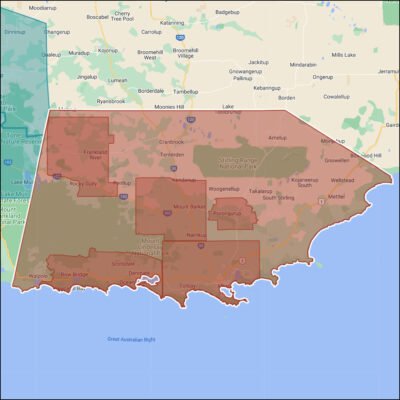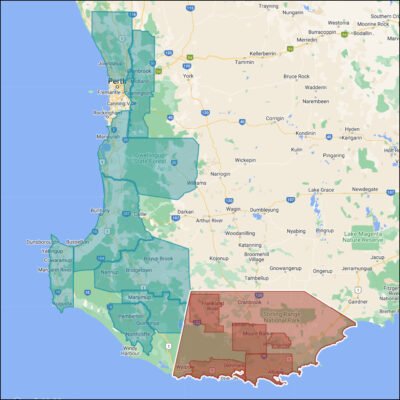The Great Southern wine region is in the southwestern corner of Western Australia, around 360km from Perth. This is the largest wine-producing region in the state, covering approximately 39,007 square kilometres. Its boundaries stretch from the Indian Ocean in the west to the Southern Ocean in the south and inland toward the Stirling Range, which plays a critical role in influencing the region’s terroir. It forms part of the South West Australia wine zone, which it shares with Margaret River, Geographe, Manjimup, Pemberton, and Blackwood Valley.
The region’s wine history dates back to the 1960s, with Mount Barker and Frankland River among the first areas to be developed. In the 1950s, Dr. Harold Olmo, a viticulturist, identified the region’s potential for high-quality wine production. By the 1970s, pioneering wineries like Plantagenet Wines had put the region on the map.
The region comprises five distinct sub-regions, each offering unique microclimates and characteristics.
Albany is close to the Southern Ocean, with cooling maritime influences. Due to the cool climate, it produces elegant and aromatic wines with higher acidity. You will find great Pinot Noir, Sauvignon Blanc, and Chardonnay varietals here.
Denmark is another coastal sub-region with higher rainfall and cooling breezes from the Southern Ocean. It is known for vibrant, fruit-forward wines with finesse and specialises in Chardonnay, Pinot Noir, Sauvignon Blanc, and Shiraz.
Frankland River lies inland and is drier than other sub-regions, with warm days and cool nights. The region produces structured, intense wines with fine tannins and depth, showcasing varietals like Cabernet Sauvignon, Shiraz, and Riesling.
Mount Barker is central to the Great Southern wine region, slightly inland with rolling hills and well-drained soils. It is the birthplace of the region’s wine production and is renowned for its high-quality Riesling, Shiraz, and Cabernet Sauvignon.
Porongurup is a small subregion near the Porongurup Range and features some of the oldest rock formations on Earth, influencing its unique soil composition. These granite-based soils and altitude-driven cooling produce elegant, mineral-driven wines like Riesling, Chardonnay, and Pinot Noir.
The Great Southern experiences a maritime-influenced climate along the coast, with Continental influence and temperature variability increasing significantly as you move north. Elevation, aspect, and sites vary widely, but generally, the climate of these northern areas is slightly warmer on the higher sites. Denmark and Albany have higher rainfall relative humidity than other sub-regions, and microclimates within subregions allow for a diverse range of wine styles.
Top Stats
Harvest
Late Feb to early Apr
Mean Jan temperature
20.7°C
Area of Vine
2,545 hectares
Altitude
0-1083m
Growing season rainfall
251mm
Principal Varietals
Great Southern tips the scales in favour of red wine production 60/40, driven by Shiraz and Cabernet Sauvignon alone, which make up half of the total wine produced.
The regional Shiraz is celebrated for its elegance, complexity, and cool-climate characteristics. It is generally medium to full-bodied with balanced acidity, showcasing a mix of dark fruit, earthy undertones, and savoury herbal notes. Some wines exhibit chocolate, liquorice, and cedar hints from oak ageing. They offer a unique expression of Shiraz, distinct from the bolder, fruit-driven styles of warmer regions like the Barossa Valley.
Cabernet Sauvignon is a standout varietal in the region, offering a refined alternative to the powerful Cabernets of warmer Australian regions like Coonawarra or Margaret River. Thanks to the cooler climate and slower ripening, they are generally medium to full-bodied with firm yet polished tannins, bright acidity, and a long, lingering finish. You will find balanced dark fruit, hints of cedar, tobacco, and earthy undertones and often exhibit a touch of spice and fine-grained oak influence.
Chardonnay is a shining example of cool-climate winemaking, with elegance, balance, and vibrant fruit expression. The regional varietal has aromas of fresh citrus (lemon, grapefruit), stone fruits (peach, nectarine), and green apple, often with subtle floral and nutty notes. These translate on the palate with crisp acidity with white peach, pear, and citrus flavours, complemented by minerality hints. Depending on the winemaking style, some may feature buttery, toasty, or creamy elements from oak fermentation or lees ageing.
Semillon is a remarkable expression of this versatile white grape variety. Known for its vibrancy, complexity, and cool-climate character, it offers a diverse range of styles, from fresh and zesty to rich and textured. It has aromas of lemon, lime, green apple and subtle grassy or herbaceous notes with hints of floral or tropical fruit. Crisp and zesty in youth, Semillon has bright citrus and green fruit flavours but develops complex secondary characteristics such as honey, toast, and nuts with age.
Sauvignon Blanc is known for its crispness, vibrant fruit flavours, and cool-climate finesse. The region’s diverse subregions and cooler conditions produce a wide spectrum of styles, from zesty and herbaceous to more textured and complex. Lime, passionfruit, gooseberry, and green apple aromas dominate, often with herbaceous notes of freshly cut grass, asparagus, or nettles. Bright citrus, tropical fruit, and green fruit flavours are common, with minerality and refreshing acidity. When oak is used, some wines may show hints of florals or a subtle creaminess. Great Southern Sauvignon Blanc is light to medium-bodied, with zippy acidity and a clean, crisp finish.
Notable Varietals
The Great Southern wine region is known for its diversity and ability to produce high-quality wines across a range of varietals. The region excels particularly in cool-climate wines, with a few standout varietals. Each subregion offers its own unique twist on the principal varieties above and some more localised specialities.
Pinot Noir is grown mainly in the coastal sub-regions of Albany and Denmark. It produces lighter-bodied, aromatic wines with bright red fruit and silky tannins.
The inland sub-regions are renowned for producing world-class Riesling, often compared to top German Rieslings.
Malbec and Merlot are typically used in blends but can produce excellent single-varietal wines with bold fruit and soft tannins.
Source: www.wineaustralia.com,









